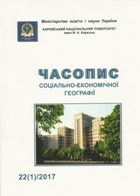Human-geographical concept of the regional geodemographic system
Abstract
The synergetic analysis of geodemographic researches indicates that they can be solved with use of modern technologies of management. according to the theory of a sotsioaktogenez, for this purpose it is necessary to define and formulate accurately the purpose of future phase transition, to construct consistent system of the purposes taking into account own and provided resources, to create executive system, effective from the point of view of optimum use of the available methods (technologies) and means of activity, and to control and analyze obtaining result. The analysis of results of social management demands the quantitative description and comparison of real result with his expected model (purpose). The offered concept of geodemographic system of the region on the basis of dissipative structures which treats people, groups of people, society is aimed at the development and functioning of the studied system where the special role belongs to implementation of administrative decisions.
In article it is covered the generalized structure of the concept, it is revealed her the purpose, an object subject area. It is defined public and spatial localization of a research, in particular within regional, region and local communities. It is identified geodemographic process as composite human and geographical process as sotsioaktogenez (with determination of stages of motivation, system of the purposes, executive system and result from a line item of society and a family) as self-development and self-organization (with determination of the internal and external factors supporting and evolutionary resources, mechanisms) as process (information exchange, external and internal adaptation). Methodological approaches (geographical, system, synergy, information, historical), research techniques (the analysis of system indices, simulation of a path of development, the component analysis) and evaluation and prognostic simulation are opened. Technological procedures and criteria of control of development of geodemographic system are provided.
The offered human and geographical concept of regional geodemographic system is directed, mainly, to creating favorable conditions for simple or expanded reproduction of the population and formation of human potential. Her realization will allow to make the detailed human and geographical analysis of geodemographic system, to reveal problem situations and to find optimum ways of their decision, it is essential to increase effective management of geodemographic process which has to provide result of implementation of the concept - optimization of regional geodemographic system at this development stage. The received result will allow his estimates and comparison with a definite purpose of correction of the purpose according to new to conditions and features of regional geodemographic system. The offered concept can be applied to a research of geodemographic systems of various regions and countries.
Downloads
References
2. Gerasimov, I. (2014). K chemu vedet dinamika entropii sotsiuma [What is the dynamics of the entropy of society]. Nauka. Religiya. Suspilstvo, 2, 79-89. Available at: http://dspace.nbuv.gov.ua/handle/123456789/87013.
3. Niemets, K. (2005). Informatsionnoe vzaimodeystvie prirodnykh i sotsialnykh sistem [Information interaction of natural and social systems]. Kh.: Vostochno-regionalnyiy tsentr gumanitarno-obrazovatelnyih initsiativ, 428.
4. Niemets, K., Niemets, L. (2013). Prostorovyy analiz u suspilniy geografii: novi pidkhody, metody, modeli [Spatial analysis in human geography: new approaches, methods, models]. Kharkiv, Ukraine: Kharkivskyi natsionalnyi universytet imeni V.N. Karazina, 228.
5. Niemets, K., Sehida, K., Niemets, L. (2016). Bahatovymirnyi analiz u suspilniy geografii (netradytsiyni metody) [Multivariate analysis in social geography (alternative methods)]. Kharkiv, Ukraine: Kharkivskyi natsionalnyi uni-versytet imeni V.N. Karazina, 120.
6. Nikolis, G., Prigozhin, I., Chizmadzheva, Yu. (ed) (1979). Samoorganizatsiya v neravnovesnykh sistemakh [Self-organization in nonequilibrium systems]. Moscow, Russia: World, 512.
7. Pistun, M. (1994). Osnovy teorii suspilnoi geografii [Basic theory of social geography]. K.: Vyshcha shkola, 156.
8. Prigozhin, I., Stengers, I. (1996). Poryadok iz khaosa. Novyi dialog cheloveka s prirodoy [Order out of chaos. A new dialogue between man and nature]. Moscow, Russia: Progress, 432.
9. Sehida, K. (2017). Geodemografichnyi protses yak sotsioaktogenez [The geodemographic process as socioactogenez]: 2017 internet conference / Conference devoted to the 35th anniversary of the Department of Economic and Social Geography in Lesya Ukrainka Eastern European National University. Lutsk (Ukraine), 45-49.
10. Sehida, K. (2017). Kryterii ta tekhnolohichni mekhanizmy upravlinnya rozvytkom geodemografichnoi systemy re-gionu [Criteria and mechanisms for technology development management regional geodemographical system]: 2017 internet conference / Ukraine Economic Development: Towards the XXI century. Kyiv (Ukraine), 60-63.
11. Tarapov, I. (1999). U posledney cherty. Intellekt, vyzhivanie i ideya kollektivizma [At the last line. Intellect, sur-vival and the idea of collectivism]. Kh.: Folio, 126.
12. Topchiev, O. (2009). Osnovy suspilnoi geografii [Basis of Human Geography]. Odesa: Astroprynt, 544.
13. Shabliy, O. (2003). Osnovy zahalnoi suspilnoi geografii [Basis of Human Geography]. Lviv: Vydavnychyi tsentr LNU im. Ivana Franka, 444.
14. Yashin, A. (2011). Fenomenologiya noosfery. 1. Teoriya i zakony dvizheniya noosfery [Phenomenology of the noo-sphere. 1. Theory and laws of motion of the noosphere]. Moskva – Tver – Tula: Triada, 304.
Copyright (c) 2017 Катерина Сегіда

This work is licensed under a Creative Commons Attribution 4.0 International License.




